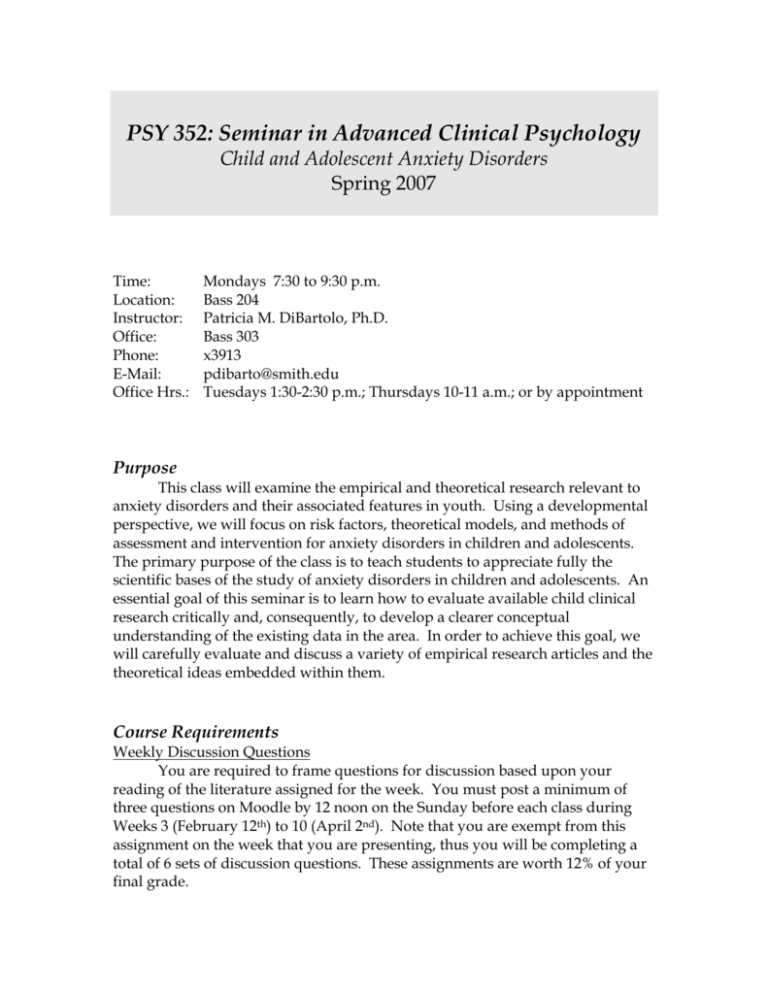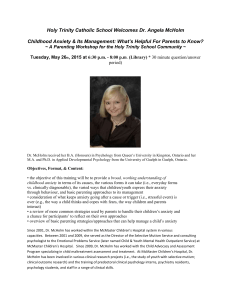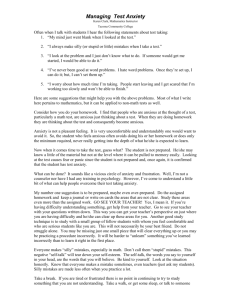Syllabus, Spring 2007
advertisement

PSY 352: Seminar in Advanced Clinical Psychology Child and Adolescent Anxiety Disorders Spring 2007 Time: Location: Instructor: Office: Phone: E-Mail: Office Hrs.: Mondays 7:30 to 9:30 p.m. Bass 204 Patricia M. DiBartolo, Ph.D. Bass 303 x3913 pdibarto@smith.edu Tuesdays 1:30-2:30 p.m.; Thursdays 10-11 a.m.; or by appointment Purpose This class will examine the empirical and theoretical research relevant to anxiety disorders and their associated features in youth. Using a developmental perspective, we will focus on risk factors, theoretical models, and methods of assessment and intervention for anxiety disorders in children and adolescents. The primary purpose of the class is to teach students to appreciate fully the scientific bases of the study of anxiety disorders in children and adolescents. An essential goal of this seminar is to learn how to evaluate available child clinical research critically and, consequently, to develop a clearer conceptual understanding of the existing data in the area. In order to achieve this goal, we will carefully evaluate and discuss a variety of empirical research articles and the theoretical ideas embedded within them. Course Requirements Weekly Discussion Questions You are required to frame questions for discussion based upon your reading of the literature assigned for the week. You must post a minimum of three questions on Moodle by 12 noon on the Sunday before each class during Weeks 3 (February 12th) to 10 (April 2nd). Note that you are exempt from this assignment on the week that you are presenting, thus you will be completing a total of 6 sets of discussion questions. These assignments are worth 12% of your final grade. Discussion Commentaries In addition to generating discussion questions prior to several of our seminar meetings, you are required to respond to the discussion questions of your classmates. In particular, during Weeks 3 (February 12th) to 10 (April 2nd), you must post commentary on Moodle before the start of seminar during three of these weeks in response to a classmate’s question(s). These commentaries are worth 3% of your final grade. Mini-Lecture Presentations You are required to provide a mini-lecture to the class once during Weeks 3 (February 12th) to 10 (April 2nd). That is, you will present a theoretical model that will help your classmates to organize the material assigned for that week. You will choose your model in consultation with me. Your responsibility during class will be to describe your theoretical model and to guide class discussion relevant to your topic. You need to coordinate your presentation with your co-presenter(s) for the week. Each presentation should be approximately 15 minutes long. This assignment will be worth 15% of your final grade. Final Written Project Over the course of the semester, you will work toward completion of a written final project that you present orally to class during one of our last meetings. You have two options to consider for your final project. One option is to complete an empirically-based case formulation for a child or adolescent with an anxiety disorder. An alternative is to submit a 15 to 20 page research proposal that describes your plan for conducting an empirical investigation in the area of childhood anxiety. All work submitted must be typed and written in APAformat. Your final project will be constructed through a series of stages that are as follows: Stage 1: Project Outline (5% of total grade) (2/19) Brief Presentation of Project Status Submit a project outline with a list of empirical references relevant to your topic. Stage 2: Expanded Outline with Article Synopsis (10% of total grade) (3/12) Brief Presentation of Project Status Expand your outline to incorporate an article synopsis for one of your empirical sources. Describe your empirical article and integrate it into your paper as a whole. Stage 3: Final Draft (25% of total grade) (4/30) Along with your final draft, you are required to submit your expanded outline. You must also submit two copies of your reference section. I will distribute separate handouts later with more explicit details of each stage. Final Project Oral Presentations You are required to present your final project to the class at some point during Weeks 11 (April 9th) to 14 (April 30th). Each student will present her project and field questions from the class. Each presentation should be approximately 30 minutes. This assignment is worth 20% of your final grade. Participation There are a number of smaller required participation assignments completed during the semester, including two brief presentations about the status of your final project, listener responses to our presenters, and exercises to prepare for your presentations. In addition, I fully expect that all members of the class will participate in regular discussion during our seminar meetings. The quality of this class is largely determined by the willingness of each member to contribute her thoughts. As such, you are assigned a participation grade at the end of the semester that reflects the quality (and frequency) of the thoughts that you share as well as the completion of the participation assignments described above. If you miss more than one seminar meeting, I will penalize your participation grade (two percentage points for each additional class missed). You can make an appointment with me at any point in the semester to receive my feedback on your participation level. Participation is worth 10% of your final grade. Calculation of Final Grade Weekly Discussion Questions Discussion Commentaries Mini-Lecture Presentation Paper Outline/References Expanded Outline with Article Synopses Final Project Oral Presentation Final Written Project Participation 12% 3% 15% 5% 10% 20% 25% 10% Grade Equivalents 100.0-95.0 90.0-94.9 87.0-89.9 83.0-86.9 80.0-82.9 A AB+ B B- 77.0-79.9 73.0-76.9 70.0-72.9 67.0-69.9 63.0-66.9 60.0-62.9 Below 60.0 C+ C CD+ D DE Honor Code You are required to abide by the Honor Code established by the college. You must be sure not to plagiarize and to provide appropriate citations for the sources you consult. Any infractions will be reported to the Academic Honor Board. Extensions Only on extremely rare occasions will extensions be granted. You must make me aware of your inability to meet your requirement deadlines prior to the date that the work is due, even if you receive an extension from your Class Dean. At that time, we will arrange a new mutually acceptable deadline for the submission of your work. If you miss a course requirement (i.e., an exam or term paper deadline) without the permission of myself or your Class Dean, you will earn none of the total points allocated for that requirement. Course Outline January 29th: Introduction Vasey, M.W., & Dadds, M.R. (2001). An introduction to the developmental psychopathology of anxiety. In M.W. Vasey & M.R. Dadds (Eds.), The developmental psychopathology of anxiety (pp. 3-26). New York: Oxford University Press. February 3rd: Assessment of Anxiety in Children Cole, D.A., Hoffman, K., Tram, J.M., & Maxwell, S.E. (2000). Structural differences in parent and child reports of children’s symptoms of depression and anxiety. Psychological Assessment, 12, 174-185. Comer, J.S., & Kendall, P.C. (2004). A symptom-level examination of parentchild agreement in the diagnosis of anxious youths. Journal of the American Academy of Child and Adolescent Psychiatry, 43, 878-886. Frick, P.J., Silverthorn, P., & Evans, C. (1994). Assessment of childhood anxiety using structured interviews: Patterns of agreement among informants and association with maternal anxiety. Psychological Assessment, 6, 372379. February 12th: Family Influences on Anxious Children Hudson, J.L. & Rapee, R.M. (2001). Parent-child interactions and anxiety disorders: An observational study. Behaviour Research and Therapy, 39, 1411-1427. Hudson, J.L. & Rapee, R.M. (2002). Parent-child interactions in clinically anxious children and their siblings. Journal of Clinical Child and Adolescent Psychology, 31, 548-555. Whaley, S.E., Pinto, A., & Sigman, M. (1999). Characterizing interactions between anxious mothers and their children. Journal of Consulting and Clinical Psychology, 67, 826-836. Requirements: 1. Weekly Discussion Questions due 2/11 by noon February 19th: Cognitive Styles of Anxious Children Bell-Dolan, D.J. (1995). Social cue interpretation of anxious children. Journal of Clinical Child Psychology, 24, 1-10. Creswell, C., Schniering, C.A., & Rapee, R.M. (2005). Threat interpretation in anxious children and their mothers: Comparison with nonclinical children and the effects of treatment. Behaviour Research and Therapy, 43, 1375-1381. Varela, R.E., Vernberg, E.M., Sanchez-Sosa, J.J., Riveros, A., Mitchell, M., & Mashunkashey, J. (2004). Anxiety reporting and culturally associated interpretation biases and cognitive schemas: A comparison of Mexican, Mexican American and European American families. Jouranl of Clinical Child and Adolescent Psychology, 33, 237-247. Requirements: 1. Weekly Discussion Questions due 2/18 by noon 2. Paper Outline/References due 2/19 in class 3. Brief Presentation of Project Status done in class 10/3 February 26th: Behavioral Models of the Development of Anxiety Lawson, J., Banerjee, R., & Field, A.P. (2007). The effects of verbal information on children’s fear beliefs about social situations. Behaviour Research and Therapy, 45, 21-37. Liberman, L.C., Lipp, O.V., Spence, S.H., & March, S. (2006). Evidence for retarded extinction of aversive learning in anxious children. Behaviour Research and Therapy, 44, 1491-1502. Muris, P., Bodden, D., Merckelbach, H., Ollendick, T.H., & King, N. (2003). Fear of the beast: A prospective study on the effects of negative information on childhood fear. Behaviour Research and Therapy, 41, 195-208. Requirements: 1. Weekly Discussion Questions due 2/25 by noon March 5th: Social Anxiety and Competence Boegels, S.M., vanOosten, A., Muris, P., & Smulders, D. (2001). Familial correlates of social anxiety in children and adolescents. Behaviour Research and Therapy, 39, 273-287. Beiderman, J., Hirshfeld-Becker, D.R., Rosenbaum, J.F., Herot, C., Friedman, D., Snidman, N., Kagan, J., & Faraone, S.V. (2001). Further evidence of association between behavioral inhibition and social anxiety in children. American Journal of Psychiatry, 158, 1673-1679. Cartwright-Hatton, S., Tschernitz, N., & Gomersall, H. (2005). Social anxiety in children: Social skills deficit, or cognitive distortion? Behaviour Research and Therapy, 43, 131-141. Requirements: 1. Weekly Discussion Questions due 3/4 by noon March 12th: Chronic Worry Gosselin, P., Langlois, F., Freeston, M.H., Ladouceur, R., Laberge, M., & Lemay, D. (2007). Cognitive variables related to worry among adolescents: Avoidance strategies and faulty beliefs about worry. Behaviour Research and Therapy, 45, 225-233. Suarez, L., & Bell-Dolan, D. (2001). The relationship of child worry to cognitive biases: Threat interpretation and likelihood of event occurrence. Behavior Therapy, 32, 425-442. Vasey, M.W., Crnic, K.A., & Carter, W.G. (1994). Worry in childhood: A developmental perspective. Cognitive Therapy and Research, 18, 529-549. Requirements: 1. Weekly Discussion Questions due 3/11 by noon 2. Expanded Outline with Article Synopses due 3/12 in class 3. Brief Presentation on Project Status in class on 3/12 March 19th: SPRING BREAK--NO CLASS March 26th: Separation Anxiety Disorder Foley, D., Rutter, M., Pickles, A., Angold, A., Maes, H., Silberg, J., & Eaves, L. (2004). Information disagreement for separation anxiety disorder. Journal of the American Academy of Child and Adolescent Psychiatry, 43, 452-460. Kearney, C.A., Sims, K.E., Pursell, C.R., & Tillotson, C.A. (2003). Separation anxiety disorder in young children: A longitudinal and family analysis. Journal of Clinical Child and Adolescent Psychology, 32, 593-598. Poulton, R., Milne, B.J., Craske, M.G., & Menzies, R.G. (2001). A longitudinal study of the etiology of separation anxiety. Behaviour Research and Therapy, 39, 1395-1410. Requirements: 1. Weekly Discussion Questions due 3/25 by noon April 2nd: Empirically Validated Treatments Readings: Cobham, V.E., Dadds, M.R., & Spence, S.H. (1998). The role of parental anxiety in the treatment of childhood anxiety. Journal of Consulting and Clinical Psychology, 66, 893-905. Kendall, P.C., & Southam-Gerow, M.A. (1996). Long-term follow-up of a cognitive-behavioral therapy for anxiety-disordered youth. Journal of Consulting and Clinical Psychology, 64, 724-730. Southam-Gerow, M.A., Kendall, P.C., & Weersing, V.R. (2001). Examining outcome variability: Correlates of treatment response in a child and adolescent anxiety clinic. Journal of Clinical Child Psychology, 30, 422-436. Requirements: 1. Weekly Discussion Questions due 4/1 by noon April 9th – April 30th : Final Project Presentations Requirements: 1. Final Project Presentations 2. Final Written Projects due 4/30 in class IMPORTANT DATES TO REMEMBER DATE 19th February March 12th April 9th – April 30th April 30th REQUIREMENT Paper Outline/References due Expanded Outline due Final Project Presentations Final Projects due REMEMBER ALSO THAT YOU MUST PROVIDE A COMMENTARY IN RESPONSE TO A CLASSMATE’S QUESTION(S) FOR THREE WEEKS DURING WEEKS 4 THOUGH 11. Name: _____________________________ FIRST PRESENTATION: MINI-LECTURE PRESENTATION Please rank the order of your presentation choices with 1 being most preferred. Rank Date FEBRUARY 12TH Topic FAMILY INFLUENCES FEBRUARY 19TH COGNITIVE FACTORS FEBRUARY 26TH BEHAVIORAL MODELS MARCH 5TH SOCIAL ANXIETY/PHOBIA MARCH 12TH CHRONIC WORRY MARCH 26TH SEPARATION ANXIETY DISORDER EMPIRICALLY VALIDATED TREATMENTS APRIL 2ND SECOND PRESENTATION: FINAL PROJECT _____ April 9th _____ April 16th _____ April 23rd _____ April 30th








